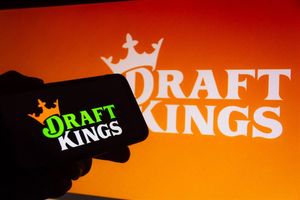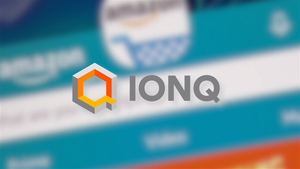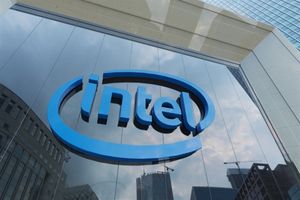
Wrapping up Q1 earnings, we look at the numbers and key takeaways for the property & casualty insurance stocks, including Progressive (NYSE: PGR) and its peers.
Property & Casualty (P&C) insurers protect individuals and businesses against financial loss from damage to property or from legal liability. This is a cyclical industry, and the sector benefits when there is 'hard market', characterized by strong premium rate increases that outpace loss and cost inflation, resulting in robust underwriting margins. The opposite is true in a 'soft market'. Interest rates also matter, as they determine the yields earned on fixed-income portfolios. On the other hand, P&C insurers face a major secular headwind from the increasing frequency and severity of catastrophe losses due to climate change. Furthermore, the liability side of the business is pressured by 'social inflation'—the trend of rising litigation costs and larger jury awards.
The 33 property & casualty insurance stocks we track reported a mixed Q1. As a group, revenues beat analysts’ consensus estimates by 2.4%.
In light of this news, share prices of the companies have held steady as they are up 1.6% on average since the latest earnings results.
Progressive (NYSE: PGR)
Starting as a small auto insurance company in 1937 with a pioneering focus on high-risk drivers, Progressive (NYSE: PGR) is a major auto, property, and commercial insurance provider that offers policies through independent agents, online platforms, and over the phone.
Progressive reported revenues of $20.41 billion, up 18.4% year on year. This print fell short of analysts’ expectations by 1.8%. Overall, it was a slower quarter for the company with a miss of analysts’ EPS estimates.
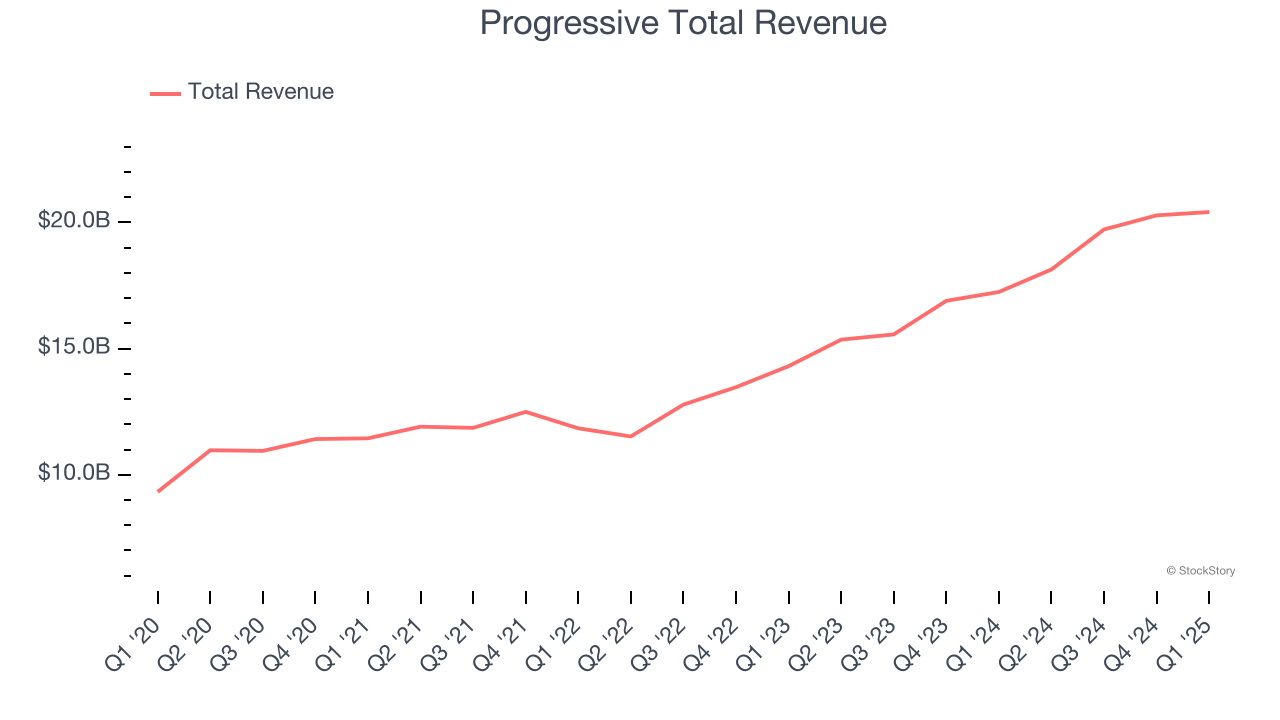
Unsurprisingly, the stock is down 8.3% since reporting and currently trades at $261.81.
Is now the time to buy Progressive? Access our full analysis of the earnings results here, it’s free.
Best Q1: Root (NASDAQ: ROOT)
Pioneering a data-driven approach that rewards good driving habits, Root (NASDAQ: ROOT) is a technology-driven auto insurance company that uses mobile apps to acquire customers and data science to price policies based on individual driving behavior.
Root reported revenues of $349.4 million, up 37.1% year on year, outperforming analysts’ expectations by 9.1%. The business had an incredible quarter with a solid beat of analysts’ EPS and net premiums earned estimates.
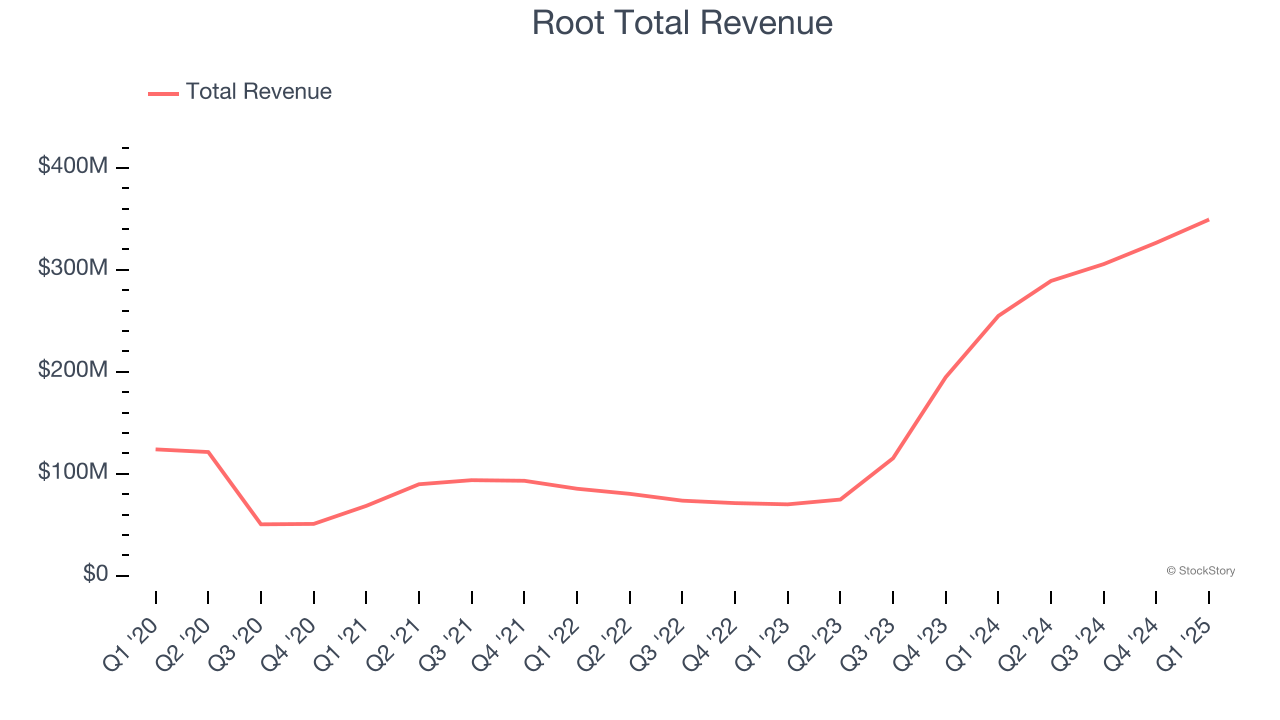
Although it had a fine quarter compared its peers, the market seems unhappy with the results as the stock is down 8.8% since reporting. It currently trades at $128.
Is now the time to buy Root? Access our full analysis of the earnings results here, it’s free.
Weakest Q1: Fidelity National Financial (NYSE: FNF)
Issuing more title insurance policies than any other company in the United States, Fidelity National Financial (NYSE: FNF) provides title insurance and escrow services for real estate transactions while also offering annuities and life insurance through its F&G subsidiary.
Fidelity National Financial reported revenues of $2.73 billion, down 17.3% year on year, falling short of analysts’ expectations by 17.9%. It was a disappointing quarter as it posted a significant miss of analysts’ EPS estimates.
Fidelity National Financial delivered the weakest performance against analyst estimates in the group. As expected, the stock is down 13% since the results and currently trades at $55.97.
Read our full analysis of Fidelity National Financial’s results here.
First American Financial (NYSE: FAF)
Tracing its roots back to 1889 when California was experiencing its first major real estate boom, First American Financial (NYSE: FAF) provides title insurance, settlement services, and risk solutions for residential and commercial real estate transactions across the United States and internationally.
First American Financial reported revenues of $1.58 billion, up 11.1% year on year. This number surpassed analysts’ expectations by 3.4%. Overall, it was an incredible quarter as it also put up an impressive beat of analysts’ EPS estimates.
The stock is up 9.6% since reporting and currently trades at $61.12.
Read our full, actionable report on First American Financial here, it’s free.
Bowhead Specialty (NYSE: BOW)
Named after the Arctic bowhead whale known for navigating challenging waters, Bowhead Specialty Holdings (NYSE: BOW) is a specialty insurance company that provides customized coverage for complex and high-risk commercial sectors.
Bowhead Specialty reported revenues of $122.7 million, up 35.3% year on year. This print topped analysts’ expectations by 1.8%. Aside from that, it was a mixed quarter as it logged a slight miss of analysts’ net premiums earned estimates.
The stock is down 10.1% since reporting and currently trades at $37.14.
Read our full, actionable report on Bowhead Specialty here, it’s free.
Market Update
Thanks to the Fed’s rate hikes in 2022 and 2023, inflation has been on a steady path downward, easing back toward that 2% sweet spot. Fortunately (miraculously to some), all this tightening didn’t send the economy tumbling into a recession, so here we are, cautiously celebrating a soft landing. The cherry on top? Recent rate cuts (half a point in September 2024, a quarter in November) have propped up markets, especially after Trump’s November win lit a fire under major indices and sent them to all-time highs. However, there’s still plenty to ponder — tariffs, corporate tax cuts, and what 2025 might hold for the economy.
Want to invest in winners with rock-solid fundamentals? Check out our Top 5 Growth Stocks and add them to your watchlist. These companies are poised for growth regardless of the political or macroeconomic climate.


